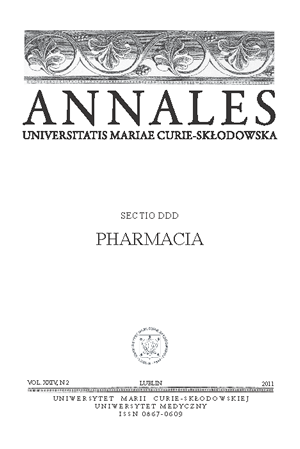The chemical composition of essential oil from the fruit of coriander (Coriandrum sativum L.)
Keywords:
Coriandrum sativum L., coriander, essential oil, linalool, camphor, GC/MSAbstract
Coriander is an oil plant used as a spice as well as for medicinal and cosmetic purposes. It has a spasmolytic, antibacterial, and carminative effect. The fruit of coriander, collected from plants grown at the Department of Vegetable Crops and Medicinal Plants, University of Life Sciences in Lublin, was used as the raw material for this research. The oil was obtained by steam distillation and subsequently its composition was analysed using the GC/MS method. Varying weather conditions prevailing during the study period did not affect the oil content and composition. The essential oil content ranged from 1.87 to 2.33% (v/w). The presence of 40 components of the coriander oil was determined, out of which 9 were unidentified. The main components of the coriander seed oil were as follows: linalool, camphor, α-pinene, geraniol, and γ-terpinene.
References
1. Argañosa G.C., Sosulski F.W., Slikard A.E.: Seed Yields and Essential Oil of Northern-Grown Coriander (Coriandrum sativum L.). Journal of Herbs, Species&Medicinal Plants, 6, 23, 1998.
2. Bhuiyan M.N.I., Begum J., Sultana M.: Chemical composition of leaf and seed essential oil of Coriandrum sativum L. from Bangladesh. Bangladesh J. Pharmacol, 4, 150, 2009.
3. Delaquis P.J. et al.: Antimicrobial activity of individual and mixed fractions of dill, cilantro, coriander and eucalyptus essential oils. International Journal of Food Microbiology, 74, 101-109, 2002.
4. Gil A., Fuente E.,B., Lenardis A.E. et al.: Coriander Essential Oil Composition from Two Genotypes Grown in Different Environmental Conditions. J. Agric. Food Chem., 50, 2870, 2002.
5. Isa T., Ozlem G.T., Nermin S.: Yield, Essentials oil content and composition of Coriandrum sativum varieties (var. vulgare Alef and var. microcarpum DC.) grown in two different location. J. Essent. Oil Res., 18, 189, 2006.
6. Matasyoh J.C., Maiyo Z.C. et al.: Chemical composition and antimicrobial activity of the essential oil Coriandrum sativum. Food Chemistry, 113, 526, 2009.
7. Msaada K., Hosni K. et al.: Changes on essential oil composition of coriander (Coriandrum sativum L.) fruits during three stages of maturity. Food Chemistry, 102, 1131, 2007.
8. Lamer-Zarawska E., Kowal-Gierczak B., Niedworok J.: Fitoterapia i leki roślinne. Wydawnictwo Lekarskie PZWLWarszawa, 312, 2007.
9. Neffati M., Marzouk B.: Changes in essential oil and fatty acid composition in coriander (Coriandrum sativum L.) leaves under saline conditions. Industrial Crops and Products. 28, 137-142, 2008.
10. Polish Pharmacopoeia VI. PTFarm., Warszawa, 151, 2002.
11. Potter T.L.: Essential Oil Composition of Cilantro. J. Agric. Food Chem., 44, 1824, 1996.
12. Rahman A.U., Choudhary M.I. et al.: Antifungal Activities and Essential Oil Constituents of Some Spices from Pakistan. Jour. Chem. Soc. Pak., 22, 60, 2000.
13. Ravi R., Prakash M., Bhat K.K.: Aroma characterization of coriander (Coriandrum sativum L.) oil samples. Eur. Food Res. Technol., 225, 367, 2007.
14. Smallfield B.M., Klink J.W. et al.: Coriander Spice Oil Effects of Rfuit Crushing and Distillation Time on Yield and Composition. J. Agric. Food Chem., 49, 118, 2001.
15. Wangensteen H., Samuelsen A.B., Malterud K.E.: Antioxidant activity in extracts from coriander. Food Chemistry, 88, 293, 2004.
16. Wong P.Y.Y., Kitts D.D.: Studies on the antioxidant and antibacterial properties of parsley (Petroselinum crispum) and cilantro (Coriandrum sativum.) extracts. Food Chemistry, 97, 505, 2006.
17. Wyk B.E., Wink M.: Rośliny lecznicze świata. MedPharm Polska, 114, 2008.
Downloads
Published
Issue
Section
License
Copyright (c) 2011 Author

This work is licensed under a Creative Commons Attribution-NonCommercial-NoDerivatives 3.0 Unported License.


